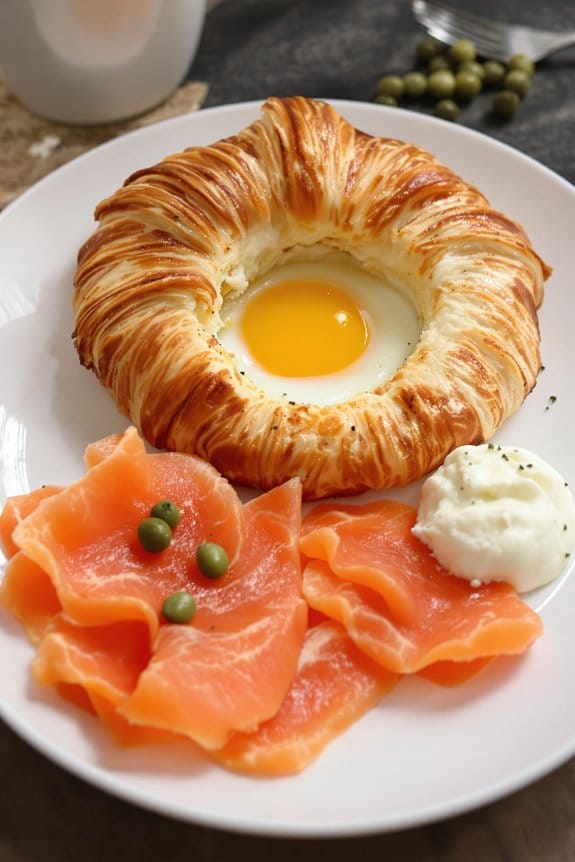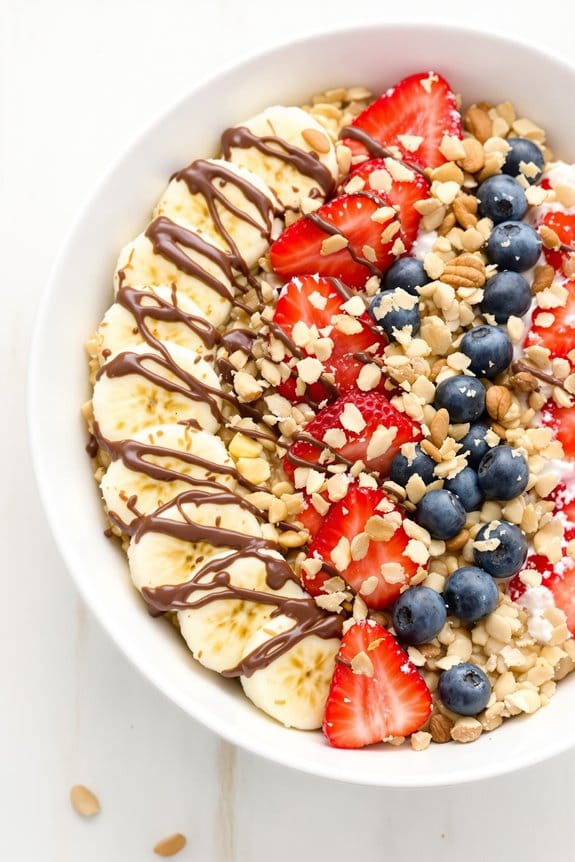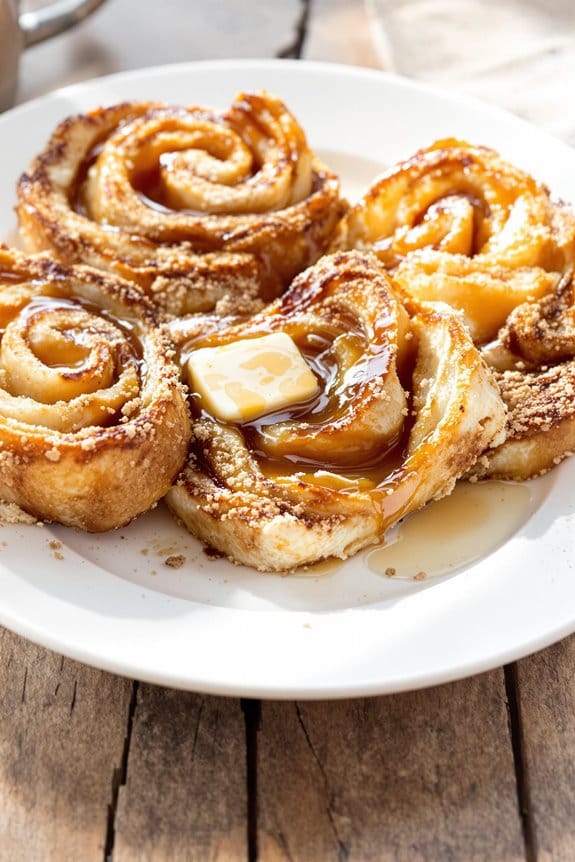Imagine starting your day with the sumptuous flavors of a croissant egg-in-a-hole topped with smoked salmon. You’ve probably savored a traditional egg-in-a-hole before, but using a buttery, flaky croissant as the base elevates the experience to a whole new level. Now, think about the addition of smoked salmon, which introduces a hint of smokiness and richness that complements the creamy texture of a perfectly cooked egg. However, as simple as it sounds, there are a few nuances to nailing this dish. What do you think is key to mastering the balance between the croissant, egg, and salmon?
History
While the croissant originally hails from Austria, the concept of adding an egg cleverly nestles into its pastry layers as a distinctly French twist on breakfast. The flaky, buttery croissant, as you might know, underwent its transformation in France, where culinary finesse turns simple ingredients into haute cuisine.
This idea of embedding a whole egg into a croissant isn’t merely about innovation; it’s a nod to the French flair for combining texture and flavor. The French are renowned for their sophisticated palate, which embraces a blend of textures and tastes, often in a single dish.
The croissant itself, rich with butter, finds a perfect match in the creamy, subtle taste of a cooked egg. The addition of the egg transforms the humble pastry into a more substantive meal, aligning with the French breakfast tradition that often includes items like soft cheese and fruit, thereby creating a balanced meal.
You’ll find that this adaptation fits seamlessly into the evolving narrative of French cuisine, which is often about enhancing the original rather than overshadowing it. This culinary evolution keeps traditional dishes alive by making them relevant to contemporary tastes, ensuring that each new generation can appreciate the heritage and innovation on their plates.
Recipe
Begin your day with a delightful twist on a classic breakfast dish by substituting traditional toast for a flaky, buttery croissant in this Croissant Egg-in-a-Hole recipe. Not only does it elevate the meal with a sophisticated flavor and texture, but it’s also incredibly simple to prepare, making it perfect for a leisurely morning or a special brunch.
The tender, airy croissant perfectly complements the richness of the fried egg, creating a combination that feels indulgent yet comforting. The key to perfecting this dish lies in the gentle handling of the croissant and the precise cooking of the egg to guarantee it’s beautifully runny or cooked to your liking.
Serve it hot from the skillet with a side of fresh fruit or a light salad for a well-rounded meal. This recipe isn’t only a joy to make but also a treat for all egg and pastry lovers.
Ingredients:
- 2 large croissants
- 2 eggs
- 2 tablespoons butter
- Salt, to taste
- Freshly ground black pepper, to taste
- Optional garnishes: chopped chives, grated cheese, or a sprinkle of paprika
Carefully slice the top off each croissant, making sure not to cut all the way through. Heat a non-stick skillet over medium heat and add butter. Once melted, place the croissants, cut side down, into the skillet. Crack an egg into the center of each croissant. Season with salt and pepper.
Cover the skillet with a lid and let cook for 3-4 minutes or until the egg whites are set but the yolks remain runny. If you prefer a firmer yolk, extend the cooking time by an additional minute or two.
A few extra tips can enhance your cooking experience and the final result. Be sure to use fresh, high-quality croissants for the best texture and flavor—day-old croissants tend to be less fluffy and more prone to breaking when handled.
If your skillet isn’t large enough to comfortably fit both croissants, cook them one at a time to avoid overcrowding, which can lead to uneven cooking. Finally, personalizing your Egg-in-a-Hole with your favorite toppings or spices can add a unique touch to this delightful breakfast, making it your new favorite morning treat!
Step 1. Cut Croissant in Half
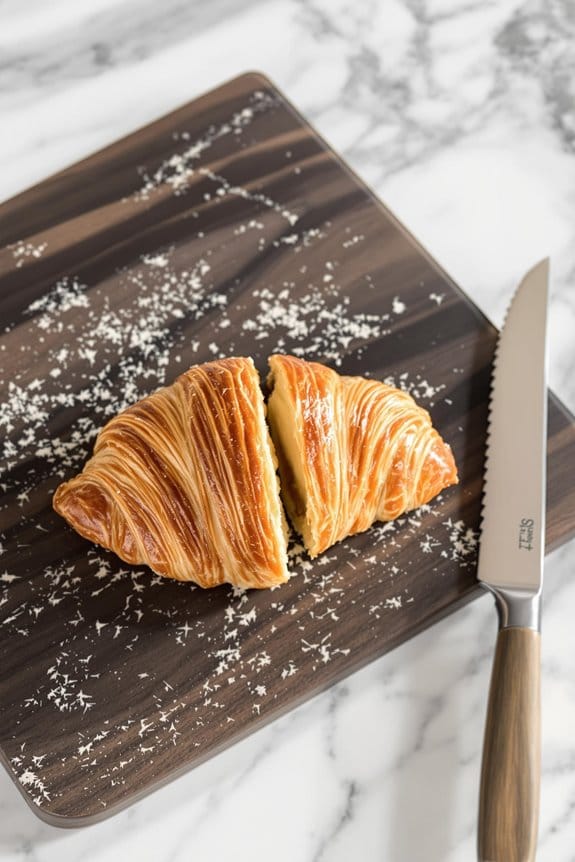
First, take your croissant and use a sharp serrated knife to gently slice it in half horizontally. It’s vital to keep the knife parallel to the cutting board to avoid tearing the delicate layers of the pastry. A steady hand guarantees the two halves remain even, which is key for the next steps of your recipe.
Once you’ve halved the croissant, set the top piece aside. You’ll be working primarily with the bottom half, so it’s important it remains intact. Check the interior for symmetry; a balanced cut provides a stable base which prevents the ingredients from spilling out later.
At this stage, resist the temptation to remove any crumbs or excess pastry, as these tiny bits will add to the overall texture and flavor once the dish is complete. The inside surface of each half should look buttery and slightly shimmerable, indicating its readiness to hold the upcoming fillings.
Also, make sure all cutting movements are smooth and slow—hasty actions might compress or damage the airy texture of the croissant, which is a central element to the dish’s final gourmet appeal.
Step 2. Add Smoked Salmon Layer

As you focus on the bottom half of the croissant, layer on thinly sliced smoked salmon to cover the surface evenly. Opt for high-quality salmon, which adds not only a rich, smoky flavor but also a touch of elegance to your breakfast. The salmon’s oiliness contrasts nicely with the buttery croissant, offering a satisfying texture and taste experience.
Remember, precision in layering is key. Each slice should slightly overlap the other, ensuring that every bite encompasses the flavorful salmon. This method also keeps the salmon from slipping off as you add more components to your creation.
For an enhanced flavor, you might consider sprinkling a little dill or capers over the salmon. These add a punch of flavor and a nice color contrast.
This step isn’t just about adding a layer; it’s about crafting a base that complements the rich, fluffy texture of the croissant while setting the stage for the next ingredients. With each slice of salmon, you’re building a foundation of flavor that will carry through the entire dish, making sure the final product is as delightful to the palate as it’s to the eye.
Step 3. Crack Egg Into Croissant
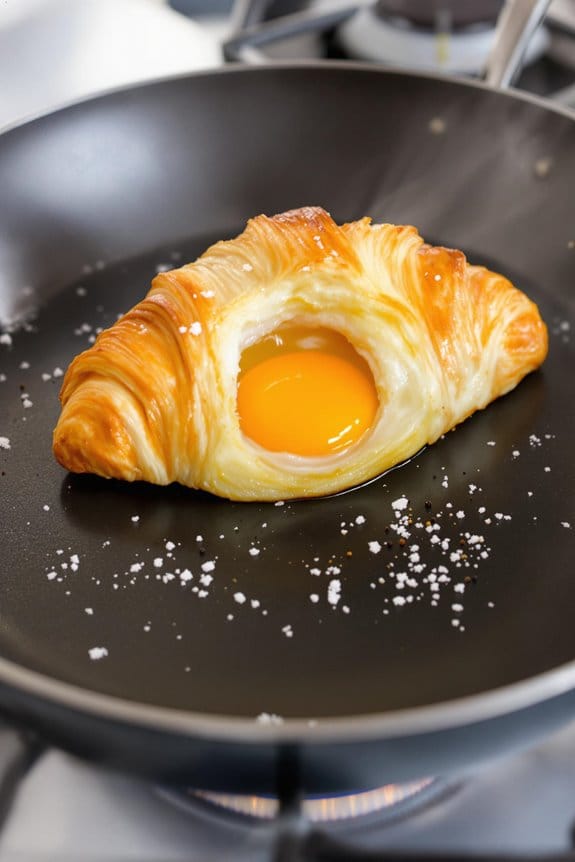
Carefully crack an egg over the center of the croissant, aiming to nestle it snugly where you’ve made the hole. You’ll want to be cautious to prevent any part of the egg from spilling over the edges. The egg should sit perfectly, showcasing its bright yolk against the golden layers of the croissant.
Now, you’ll need to adjust the heat to guarantee that the egg cooks evenly without over-browning the bottom of the croissant. The goal here is to achieve a delicate balance where the egg whites set just right, and the yolk remains slightly runny, forming a creamy contrast with the crisp, buttery pastry.
As you monitor the cooking, consider tenting the croissant with a piece of aluminum foil. This simple technique helps to gently steam the top part of the egg, making certain that the whites firm up without having to flip the entire croissant, which might risk breaking the yolk or squashing the delicate pastry.
Patience is essential at this stage. Give the egg the time it needs to cook through, occasionally lifting the foil to check its progress.
When done, the combination of textures and flavors will be a rewarding result of your attention and care.
Step 4. Sprinkle With Capers and Dill
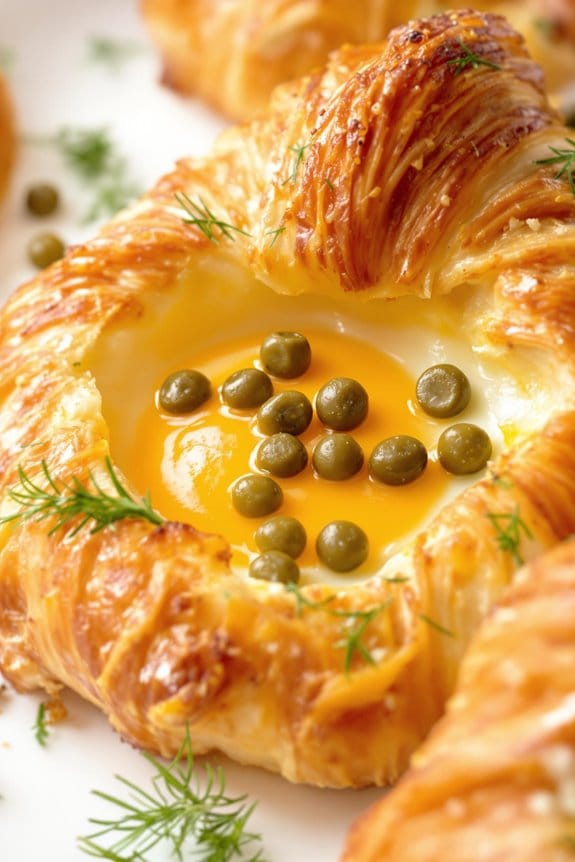
Now that your egg is perfectly situated and cooked in the croissant, it’s time to add a burst of flavor. Grab your capers and dill; these aren’t just garnishes but key players in elevating your dish. Capers, small yet mighty, bring a tangy and briny punch that contrasts beautifully with the rich, flowing yolk. Sprinkle a teaspoon of these flavor-packed buds over your egg, ensuring even distribution for a consistent bite.
Next, take fresh dill, a herb that’s not only vibrant in color but also in taste. Its light, grassy notes will complement the saline depth of the capers, adding a level of freshness that wakes up the palate. Chop the dill finely to release its aromatic oils, and then scatter it generously across the top of your croissant egg-in-a-hole.
This combination of capers and dill doesn’t just add layers of flavor; it also introduces a delightful textural contrast to the softness of the baked egg and the flaky pastry.
Every forkful will bring a crunch that’s as satisfying as it’s surprising, guaranteeing that your breakfast is anything but ordinary.
Step 5. Bake Until Egg Sets
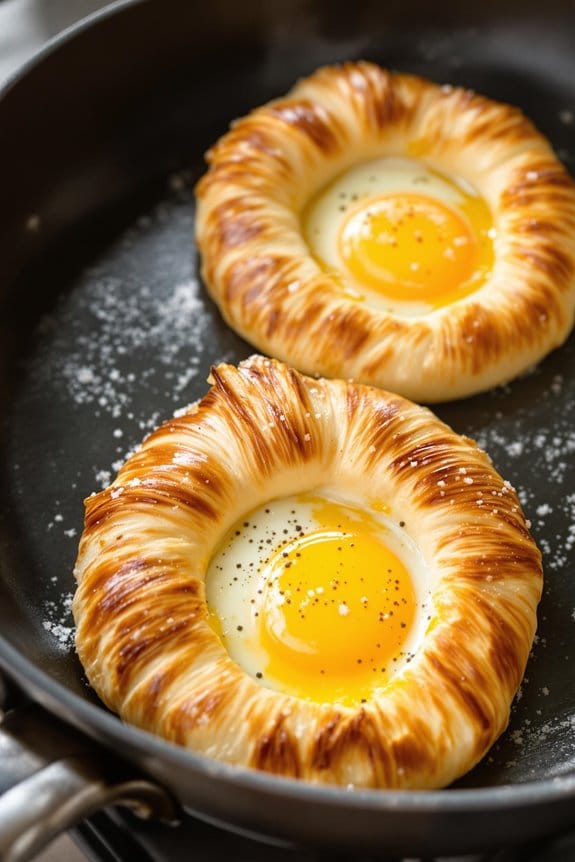
After adding the capers and dill, it’s time to focus on cooking your creation to perfection. Pop the egg-filled croissant into a preheated oven—at 375°F—and let the magic happen. Your focus now should be on ensuring the egg sets just right, so keep an eye on the oven. You’re aiming for egg whites that are firm and yolks that maintain a gentle flow when punctured—dreamy and delicious!
This baking step is essential. If you bake it too long, the yolks harden, and the croissant might turn overly crispy, losing its flaky tenderness. On the other hand, underbaking could leave you with a runny white that’s not too appetizing. You’ll need about 12 to 15 minutes to get the perfect balance. Every oven is a bit different, so don’t hesitate to make adjustments based on what you see.
Towards the end, insert a toothpick near the yolk. If it comes out mostly clean, but not entirely dry, your breakfast masterpiece is ready to come out. Letting it sit for a couple of minutes will let the egg finish setting up without overcooking.
Now, you’re all set to plunge into a mouth-watering experience. Enjoy every bite!
New Recipe
- Pepperoni and Hot Honey PizzaTry the tantalizing twist of pepperoni pizza with hot honey, where sweet meets heat—how will it transform your taste buds?
Cooking Tips
When making a croissant egg-in-a-hole, it’s essential to guarantee your croissant is fresh and buttery for ideal flavor and texture. You’ll want to handle it with care to preserve its flaky layers.
Place it gently on a flat surface, and using a small, sharp knife, cut a circle large enough for an egg to nestle comfortably without spilling over the edges. This precise cutting is key to ensuring your croissant doesn’t lose its structural integrity.
Next, it’s important to correctly adjust your pan’s temperature. Medium heat works best as it allows the egg to cook evenly while giving the croissant a golden, crispy texture without burning it.
Also, consider using unsalted butter for frying; it prevents your dish from becoming overly salty, especially since the smoked salmon will add its own saltiness.
Moreover, when you crack the egg into the croissant, do it slowly. If you’re unsure, you can crack the egg into a small bowl first, then gently pour it into the hole. This technique helps avoid breaking the yolk and gives you control over its placement, ensuring both aesthetic appeal and perfect yolk placement for that irresistible run when you slice through.
Final Thoughts
While cooking the croissant egg-in-a-hole, you’ve applied precise techniques to maintain the integrity of the pastry and optimize the flavors.
You’ve confidently navigated the culinary process, making sure that each element from the flaky croissant to the tender smoked salmon harmonizes beautifully. Here you stand, reflecting on the journey and the delicious result of your efforts.
As you savor the final product, consider these key takeaways from your experience:
- Ingredient Quality: The superior quality of the smoked salmon and fresh eggs contributed notably to the dish’s overall flavor. Always select the best ingredients within your reach.
- Temperature Control: Managing the heat was vital to avoid burning the croissant while fully cooking the egg. This delicate balance made certain that every bite was as perfect as intended.
- Presentation: The visual appeal of your dish, with its golden-brown croissant and vibrant accents from the salmon and herbs, not only pleased the eye but also enhanced the dining experience.

